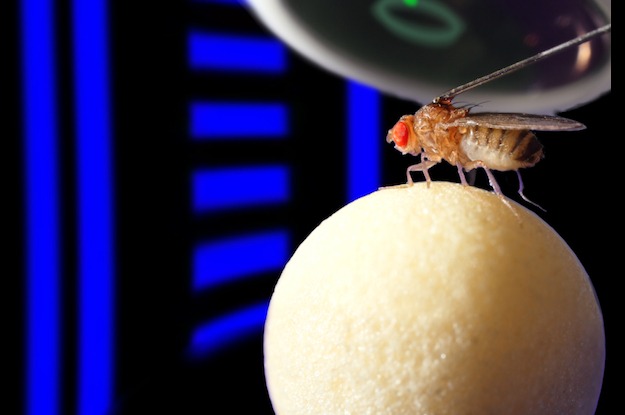
If you walk into a dark room, you can still find your way to the light switch. That’s because your brain keeps track of landmarks and the direction in which you are moving. Fruit flies also boast an internal compass that works when the lights go out, scientists in the Jayaraman Lab have discovered. Their findings suggest that dissecting how fruit flies navigate through the world could help researchers understand how humans and other mammals perform similar tasks.
In our brains, several kinds of neurons help us get and keep our bearings. Head direction cells, for example, use landmarks to report our orientation in our surroundings. These cells also register how much we turn, allowing us to steer in the right direction – at least for a while – even if landmarks are unavailable.
Mammalian brains are complex, however, and researchers might be able to investigate important aspects of how such cells work by studying fruit flies, says group leader Vivek Jayaraman. Fruit fly brains are smaller and contain fewer neurons, and researchers have powerful genetic tools for monitoring and perturbing specific neurons and neural circuits in these insects. But scientists weren’t sure if flies had neurons similar to head direction cells.
To find out, Vivek’s postdoctoral fellow Johannes Seelig put flies into a tiny virtual reality arena. Each fly, which is tethered to prevent it from taking off, “plays a role-playing game,” says Vivek. It walks on a small rotating ball while facing a curved LED screen that shows different visual patterns. A fly usually heads for vertical stripes, and the researchers synchronized the rotation of patterns on the screen to the rotation of the ball, creating the illusion that the background was moving as the fly turned.
Using a two-photon laser scanning microscope and Janelia-made genetic tools that cause neurons to glow brightly as calcium levels inside neurons increase, the researchers could monitor whether specific cells in the fly’s brain fired during the experiments. The scientists zoomed in on the ellipsoid body, a donut-shaped structure in the middle of the fly’s brain where they suspected the insect version of head direction cells might reside.
The activity of the neurons in the ellipsoid body indicates the direction the fly is traveling, the researchers found. If the LED screen showed a visual panorama with a complex pattern of horizontal and vertical stripes, neurons in the ellipsoid body locked on to it, creating a single spot of activity in the ellipsoid body that tracked the fly’s orientation in the virtual environment. When the fly shifted the visual panorama to the left or the right by turning, the location of the active spot in the ellipsoid body followed. In a paper published online on May 13, 2015 in Nature, Seelig and Vivek suggest that the ellipsoid body functions like a compass. “We think we have a window into the fly’s internal model of its world,” says Vivek.
>Read more from HHMI
